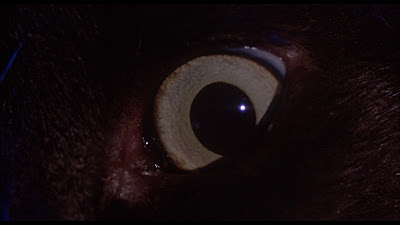 |
| From http://wrongsideoftheart.com/wp-content/gallery/posters-i/inferno_poster_02.jpg |
Dir. Dario Argento
Italy
[It’s been a while since this has been added to a “Cinema of the
Abstract” review, but for anyone reading this blog for the first time, this is part
of a collection of reviews of unconventional and experimental films that I have
been housing on my MUBI profile and will continue to expand. The link to it is here.]
 |
| From http://brandonfilm.files.wordpress.com/2011/11/inferno-bluecorridor.png |
If there was ever a film obsesses
with the shape and enclosure of corridors, secret passages hidden in buildings
that leads to dark machinations, it is Dario
Argento’s follow-up to his legendary film Suspiria (1977). The characters can only follow along in this
film’s locations, a hotel with numerous connecting pipes and air pockets that
allow voices to be heard in varying rooms, libraries with rooms full of
bubbling pots of viscous liquid, places which show more and more but shrink the
presence of the individual within them against everything they encounter. With
this film, Argento himself expanded
the tone and content of Suspiria by
expanding the mythology. With Inferno
you have the Three Mothers introduced, three witches of immense evil. The
Mother of Sighs, depicted in Suspiria,
the Mother of Tears, who is in this film but is devoted to completely in the
2007 film that turned this series of films into a trilogy, and the Mother of
Darkness, who is centre to Inferno. Inferno is a mood piece, which caught
me off guard on the first viewing even though I had come to expect this sort of
tone with Suspiria. It does have a
simple story that the film leaps from into this. The information of the Three
Mothers’ existence, in old published editions of a diary of the architect who
created their homes, is starting to be violently suppressed by the influence of
the remaining Mothers, pulling in the brother of a girl who, living in New
York, the home of the Mother of Darkness, starts this series of deaths by
acquiring a copy of the book.
 |
| From http://www.dvdbeaver.com/film3/blu-ray_reviews53/inferno_blu-ray_/large/large_inferno_blu-ray_6x.jpg |
Everything that made Suspiria what it was – the atmosphere,
the bright coloured lighting, the methodical pace intercut with brutal deaths –
is continued in Inferno but it
proved to be a lesser known, even divisive, continuation, probably because it
strips the plotting down to its minimum on purpose, and more significantly
splits up the film into segments following different characters. On a first
viewing, you will not know what to expect with Inferno, especially when individual unexpectedly die. In Suspiria there was a clear protagonist,
but here it is the expansion of the mythology which is central to the film and
how it is violently discovered is the driving force for everything around it. On
this viewing, this presentation was perfect, Dario Argento playing with the tropes of this area of gothic horror
while letting himself have the most bravado moments in his filmography in terms
of content. Everything is to a high standard – the camera movements he used,
the colour lighting and set design, Keith
Emerson’s score – and presents numerous moments that are instantly
memorable. It’s hard to top this film’s most well known scene that is the first
set piece, of a room underwater presented to the screen in a way that is
strangely calming before the punch line to it takes place, but the film’s
supernatural atmosphere increases as it goes along and the film’s various
strands are cut to down to the final reveal of who the Mother of Darkness truly
is. A lot of what is Argento’s
virtue, which I criminally ignored, is how much his excess style is a stronger foundation
for his filmmaking to rest upon than one takes for granted. His seventies and eighties
output in hindsight is deliberately unconventional, and a lot better written
than people have presumed it to be if it is viewed as a jumping off point for
his to craft images from. He is very much a director who explains everything
through images unless it’s a giallo mystery story or a key plot point he couldn’t
have shown through said images. He uses a simple premise or idea, and expands
it through the images and music. The final film onscreen is an intense,
haunting romp through this area of cinema.
These thoughts apply to all of
the films of his I’ve rewatched this year as well, finally *getting* the
virtues of his work at their fullest. There’s not more I can actually say than
to request all of you reading this review to watch Inferno. If you’re cold on it and haven’t watched it in a while,
try rewatching it again with these words in mind.
 |
| From http://www.dvdbeaver.com/film3/blu-ray_reviews52/inferno_blu-ray_argento_/large/large_inferno_blu-ray_8x.jpg |

.jpg)
No comments:
Post a Comment